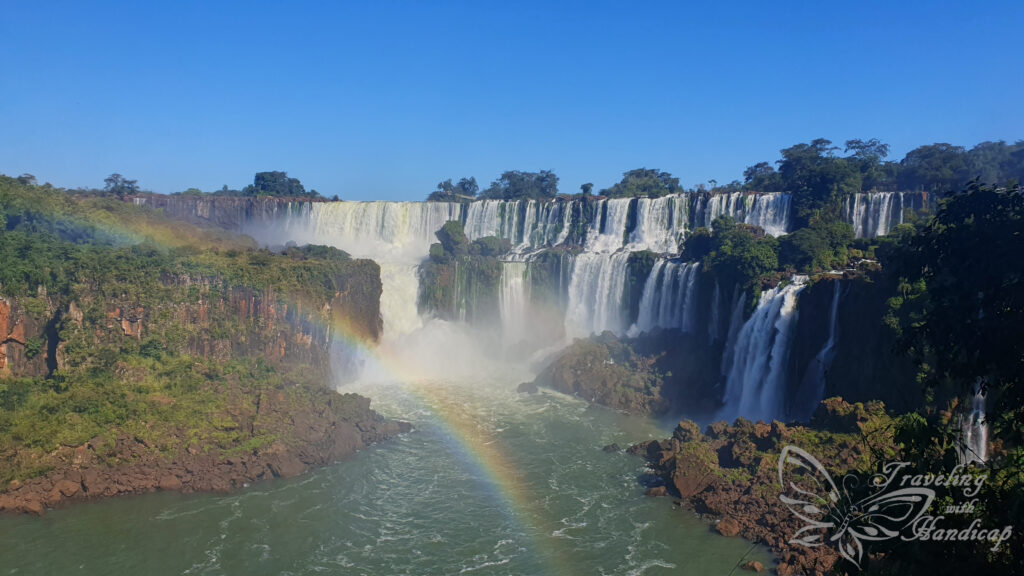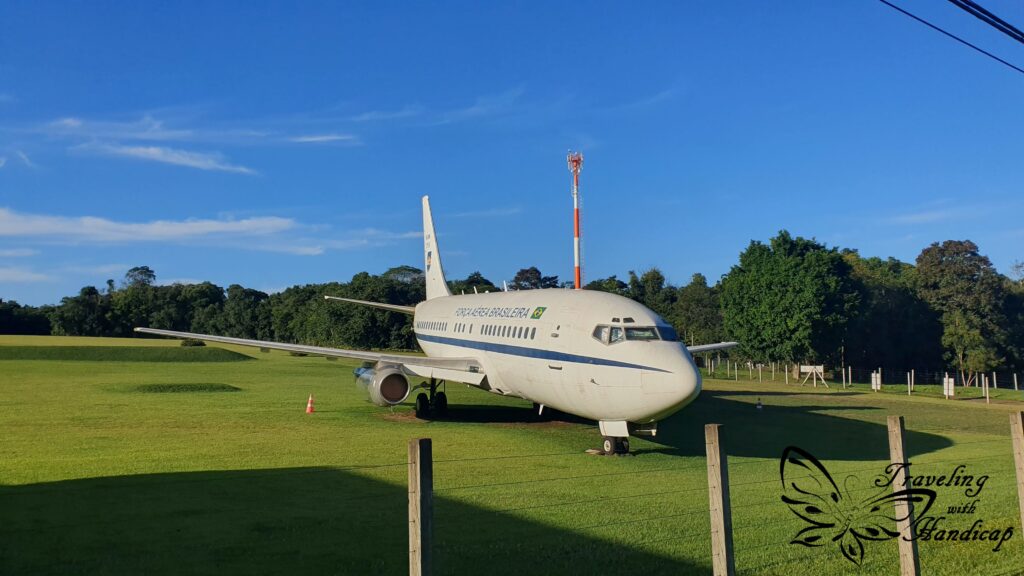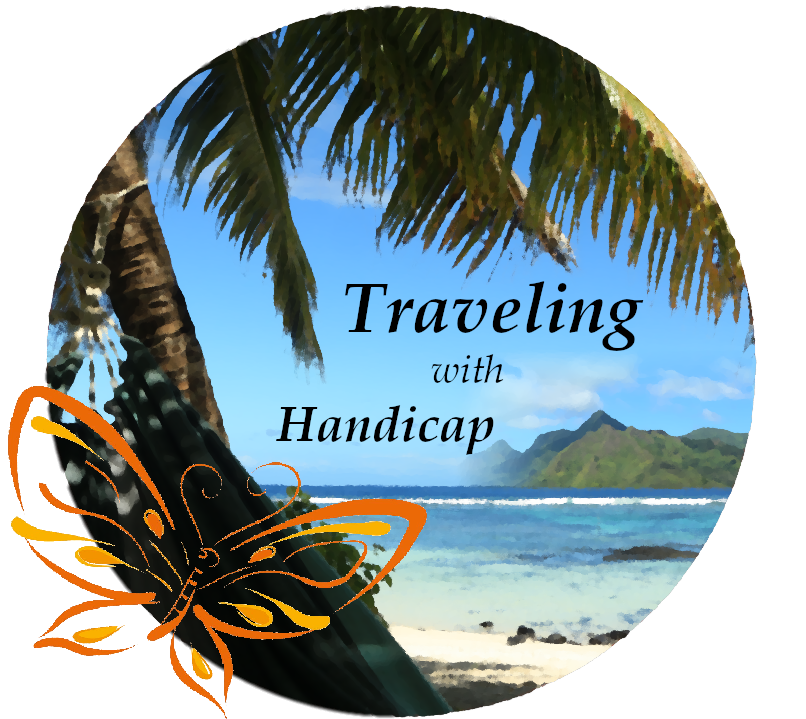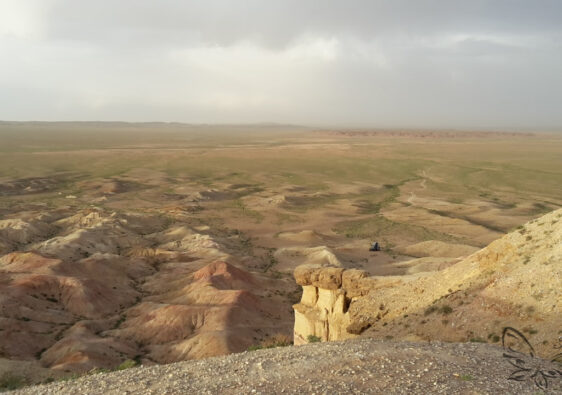Aim for the sky, but move slowly, enjoying every step along the way. It is all those little steps that make the journey complete.
Chanda Kochhar
The Iguazú Falls
The Iguazú waterfalls are waterfalls of the Iguazú river, therefore the name. The origin of the name Iguazú are the Guaraní or Tupi words “y” for “water” and “ûasú” for “big”. This makes sense, the falls are gigantic.
- Spanish: Cataratas del Iguazú
- Portuguese: Cataratas do Iguaçu
The Iguazu river follows the border of the Argentinean province Misiones and the Brazilian state of Paraná. Most of the falls are located in Argentina. Therefore, you can get quite close to the falls from the Argentinean side but have a better panoramic view from the Brazilian side. From Brazil, you get an idea of the pure size of the falls which makes up the largest waterfall system in the world.




From the Argentinean side
When visiting the Iguazú waterfalls in Argentina, the bus-dropoff and parking area is located at the entrance to the National Park. There you pay for your ticket and also get a ticket for a boat ride with another agency if you like. In my opinion, the boat ride is not necessary, though. You will get wet anyway, just by visiting the falls, and the boat is super expensive.
Train
With your ticket, you enter and walk to the station that hands out the train tickets. The train is included in the ticket price but only a limited number of seats is available every 30 minutes. This is why you should get your hands on a train ticket quickly. There is nothing more boring than waiting for a train for an hour. In theory, you could walk to some falls within this hour, but one hour is not really a sufficient time to enjoy it.

The train brings you to the Paseos de Luna Llena from where you may walk along a track over the water towards the Garganta del Diablo. It also indicates a return time 2 hours later. This time window is sufficient for the Garganta del Diablo. If you really need more time, you may walk (but very long). After the Garganta del Diablo, you may get off at the starting points for the superior and inferior walking circuits or go back to the entrance if you visited those two circuits before.





Garganta del Diablo
After your visit of the Garganta del Diablo, you will most likely agree with its name, the devil’s throat. Most likely you will be wet afterward, as the power and amount of falling water causes continuous splashing. Expect to have “rain” blowing around you from all directions. I realized that glasses are useless, you won’t see anything as soon as they are wet and don’t get dry. A waterproof camera is convenient for taking pictures of the devil. 😉



Circuito Superior
This walkway (round-way) approaches the falls from the top and offers some panoramic views. However, the falls are not as impressive if you look at them from the top and don’t really see their bottom. The circuit is one-way, people usually gather at the viewpoints. In between, along the track, you might even walk on your own not seeing anyone.





Circuito Inferior
The lower circuit approaches the waterfalls from further down. Both the upper and lower circuit are far away from the Garganta del Diablo, you visit many of the smaller falls. The cool aspect of these is that they don’t carry as much water. As such, you don’t get completely wet and may enjoy the landscape of green plants and the water finding its way through.





Attention to wildlife!!!
The Iguazu national park is a refuge for many endangered species. Most likely you won’t meet pumas or jaguars, they live within the region though. There is also a high diversity of insects, I recognized many colorful butterflies. If you watch the trees carefully while walking, you might also encounter little monkeys hiding in the trees.
These animals seem to be friendly. But not all of them truly are. I assume nobody leaves the Iguazu Waterfalls (on the Argentinean side) without seeing coatis. They are the most common animals to see, but I’ve been more relaxed whenever I didn’t see them. This is because they have huge claws, are really fast and obsessed by (human) food. If you have food in your bag, they smell it and try to get to it. So don’t put your backpack on the ground, a seat, or a table (they are fast and good climbers). If they approach you too closely, give them a short and fast kick with your boot.
In theory, you could keep your backpack on your back and eat in a standing position. However, there are many types of birds in the park and at least one of them collaborates with the coatis. Whenever you try to eat while standing or walking, the bird nosedives to your hand and tries to grab your food such that you leave it falling to the ground – for the coatis.



From the Brazilian side
At the entrance to the national park in Brazil, you get your ticket which also has a time for your bus. The entrance is further away from the falls, similar to Argentina. However, instead of the cool train in Argentina, you have shuttle buses in Brazil. With the bus, you could get off at a stop to a boat tour, which I wouldn’t recommend similar to Argentina.

The final stop of the bus is a walkway along the coast ending at the Devil’s Throat, just on the Brazilian side. Opposite to Argentina, the walkway in Brazil contains many stairs, therefore it is not accessible. If you have problems with stairs, you get in a different bus which shuttles you to the pickup point at the end of the walkway. There, close to the Devil’s Throat, is a viewing tower with a lift and an accessible path further “into” the falls.




Along the walkway, I was really impressed by the size of the Iguazu waterfalls. The Niagara Falls are tiny and boring compared to Iguazu. Even though you get much closer to many falls on the Argentinean side, I enjoyed the Devil’s Throat part in Bolivia more. You are quite close to the falls, get wet, and have a much better panoramic view from the big falls than from Argentina.





If you have to decide for only one country / spot
There are pros and cons for each side. From my perspective, the panoramic view from Brazil is great. Nevertheless, I would recommend the Argentinean side if you only have one day available. This is because you can get really close to the falls not only once on Argentinean side and there are also some spots with great panoramic views. Moreover, and my most important reason for preferring Argentina, is the accessibility and the amount of help people with restrictions got.
All three main walking routes are possible to be done with a wheelchair. Since regular wheelchairs might get stuck, there are “outdoor wheelchairs” with bigger wheels available to swap. As well, there are transport buggies like the ones at airports which transport people who are not able to walk far distances. There is not really text to read except for the names of the waterfalls, but I even encountered one info sheet in braille. On top of all these points, I was provided free entrance to the whole Argentinean falls complex by showing my German disability card (while in Brazil I had to pay the full fare).
What else to do
In Argentina
The town of Puerto Iguazú is very close to the borders with Brazil and Paraguay. Each of the three countries contains some stone saying something similar to “Three-Country Point”. While these points are further away from the towns of Foz do Iguaçu in Brazil or Ciudad del Este in Paraguay, respectively, it’s in walking distance from the center of Puerto Iguazu.
This point is quite touristy, also the local bus of Puerto Iguazú stops close to the punto de tres fronteiras. The view and atmosphere is great for sunset.


In Brazil
Very close to the entrance to the National Park Foz do Iguaçu is the Parque das Aves (bird park). It’s only a 5 minutes walk. As you don’t need a full day walking along the walkway of the falls in Brazil, you should use your remaining time to visit this park.









In this park, diverse types of birds are protected and kept. You may even walk through their huge cages while the birds are flying around you. The park is bigger than I initially thought. While walking, you may listen to a broad diversity of different bird sounds. Simply listening was so relaxing. Moreover, there are cafés in the park offering healthy food (fruit) with drinks while listening to birds and relaxing music. I could have stayed in the bird park for several hours, just sitting at the many banks and listening to the birds.










How to get there and where to stay
You have the option to stay either in Argentina or Brazil to be close to the falls. I would recommend staying in Argentina, though. This is because the town Puerto Iguazú is really set up, ready and prepared for the tourism, also across borders. There are frequent buses to both the Argentinean and the Brazilian falls from the terminal in Puerto Iguazú. When I crossed the terminal in Foz do Iguaçu in Brazil, I couldn’t find proper information on buses towards any side of the falls.
I recommend booking a hostel close to the bus terminal as all shuttle buses (to both sides of the falls and the airport in Argentina) head off from there. There are also a few long distance bus connections available, mainly towards Buenos Aires, but also a few towards Río.


If you accept a little walk of approximately 1 km and a waiting time at the border to Brazil of one hour for the next bus, then you may as well take the shuttle towards the Brazilian falls. With that bus, you have to get off at the crossing with the street towards the airport of Foz do Iguaçu.




